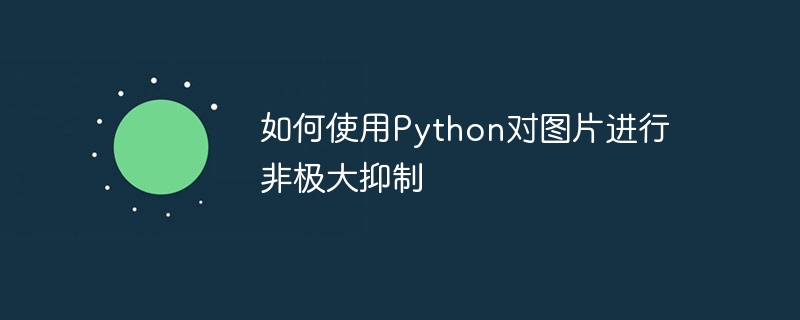
Python을 사용하여 이미지에서 비최대 억제를 수행하는 방법
비최대 억제는 컴퓨터 비전에서 일반적으로 사용되는 이미지 처리 기술로, 이미지의 가장자리나 모서리를 추출하는 데 사용됩니다. 이 기사에서는 OpenCV 라이브러리와 함께 Python 프로그래밍 언어를 사용하여 최대가 아닌 이미지 억제를 구현합니다.
먼저 Python 및 OpenCV 라이브러리가 설치되었는지 확인하세요. pip를 사용하여 OpenCV 라이브러리를 설치할 수 있습니다: pip install opencv-python. pip install opencv-python。
然后,导入所需的库:
import cv2 import numpy as np
使用OpenCV的cv2.imread()函数加载图像,并使用灰度图像处理方法将图像转换为灰度图像。灰度图像只包含一个通道,并更容易处理。下面的代码演示了如何加载和预处理图像:
# 读取图像
image = cv2.imread('image.jpg')
# 转换为灰度图像
gray = cv2.cvtColor(image, cv2.COLOR_BGR2GRAY)非极大抑制是基于图像梯度的,并使用梯度的大小和方向来判断是否是极大值。我们可以使用cv2.Sobel()函数计算图像的梯度。
# 计算x和y轴方向的梯度 gradient_x = cv2.Sobel(gray, cv2.CV_64F, 1, 0, ksize=3) gradient_y = cv2.Sobel(gray, cv2.CV_64F, 0, 1, ksize=3) # 计算梯度的大小和方向 magnitude = np.sqrt(gradient_x ** 2 + gradient_y ** 2) angle = np.arctan2(gradient_y, gradient_x)
接下来,我们将使用梯度的大小和方向来进行非极大抑制。对于每个像素,我们将检查其相邻的两个像素,如果梯度的大小比相邻像素大,并且在梯度方向上是极大值,则保留该像素作为边缘。
# 非极大抑制
suppressed = np.zeros_like(magnitude)
for y in range(1, magnitude.shape[0] - 1):
for x in range(1, magnitude.shape[1] - 1):
current_gradient = magnitude[y, x]
current_angle = angle[y, x]
if (current_angle >= 0 and current_angle < np.pi / 8) or (current_angle >= 7 * np.pi / 8 and current_angle < np.pi):
before_gradient = magnitude[y, x - 1]
after_gradient = magnitude[y, x + 1]
elif current_angle >= np.pi / 8 and current_angle < 3 * np.pi / 8:
before_gradient = magnitude[y - 1, x - 1]
after_gradient = magnitude[y + 1, x + 1]
elif current_angle >= 3 * np.pi / 8 and current_angle < 5 * np.pi / 8:
before_gradient = magnitude[y - 1, x]
after_gradient = magnitude[y + 1, x]
else:
before_gradient = magnitude[y - 1, x + 1]
after_gradient = magnitude[y + 1, x - 1]
if current_gradient >= before_gradient and current_gradient >= after_gradient:
suppressed[y, x] = current_gradient最后,我们使用cv2.imshow()
# 显示结果
cv2.imshow('Original Image', image)
cv2.imshow('Non-maximum Suppressed Image', suppressed)
cv2.waitKey(0)
cv2.destroyAllWindows()cv2.imread() 기능을 사용하여 이미지를 로드하고 회색조 이미지를 사용합니다. 처리 방법은 이미지를 회색조 이미지로 변환합니다. 회색조 이미지에는 채널이 하나만 포함되어 있어 처리하기가 더 쉽습니다. 아래 코드는 이미지를 로드하고 전처리하는 방법을 보여줍니다. 🎜rrreeecv2.Sobel() 함수를 사용하여 이미지의 기울기를 계산할 수 있습니다. 🎜rrreeecv2.imshow() 함수를 사용하여 원본 이미지와 최대가 아닌 억제 결과를 표시합니다. 코드는 다음과 같습니다. 🎜rrreee🎜위는 Python을 사용하여 이미지를 최대로 억제하지 않는 완전한 샘플 코드입니다. 위 단계를 통해 Python 및 OpenCV 라이브러리를 쉽게 사용하여 이미지의 가장자리나 모서리를 추출하는 비최대 억제를 구현할 수 있습니다. 더 나은 결과를 얻기 위해 필요에 따라 매개변수와 코드 논리를 조정할 수 있습니다. 🎜위 내용은 Python을 사용하여 이미지를 최대로 억제하지 않는 방법의 상세 내용입니다. 자세한 내용은 PHP 중국어 웹사이트의 기타 관련 기사를 참조하세요!